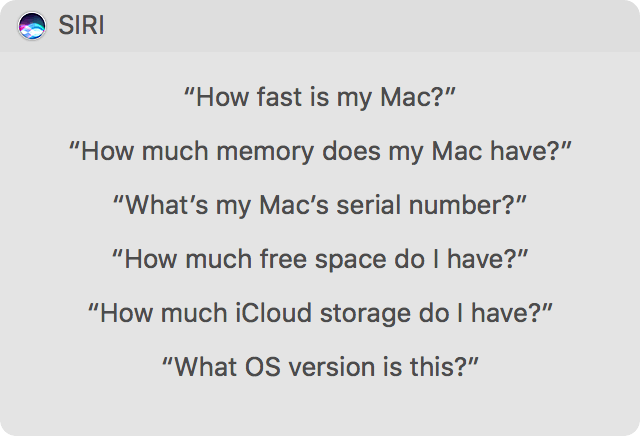This fall, Apple brought its virtual assistant Siri to Mac desktop and laptop computers.
Virtually everything you can do with Siri on your iPhone you can also do on a Mac computer: Both can get a box score, play music, or bring up photos you took last week. But there are a few significant differences.
Let’s start with the good stuff.
1. Cards generated by Siri on a Mac are shareable
Ask Siri a question on a Mac, and a card is generated.
Without the need to do anything, each query produces a png image that can be dragged and dropped, saved, or shared.
Everyone knows how to take a screenshot on an iPhone, but Siri is a different animal when it allows you to share a map or a list of files, or drag and drop a plane itinerary or restaurant reservation.
You can even drag and drop images you search from your own files or the web to your desktop or into the body of text or an email.
You can also turn any query you like into a fixed feature in your Mac Notification Center tab (the thing that slides out from the right-hand side of your screen). So if you’re really into a local band or hit upon something you don’t want to forget, just add it to the Mac Notification Center tab.
This feature makes me want a more flexible Siri, though. I want to be able to share my Siri queries with a friend or colleague. And whether it’s with a link or some other means, I want them to be able to interact with the query, so we can collectively plan a night out or a vacation together.
This is already possible with Apple’s iMessage, as well as Google’s Allo and Microsoft’s Skype.
With time and more functionality, this ability to share a Siri query with others could be kind of amazing, and it could help people begin to view a virtual assistant a lot more like they do a real assistant.
2. You can ask about your Mac’s diagnostics
Siri on Mac can tell you about your computer and answers questions like “How many free gigabytes of memory do I have?” and “How much iCloud storage do I have?”
There are other questions, but if you run through gigabytes like I do, you’ll appreciate the ability to ask how much space is left on your hard drive.

3. Search based on your habits
You can ask for specific file names but also for things like “Show me spreadsheets I was working on last week” or “Show me TextEdit files I was working on last week” or even “Show me the PDF I worked on with Jordan last week.” Being able to ask for files you worked on with others is a nice touch.
My favorite part is that you can look at all the files you opened within a particular range of time. The majority of the work I do is on my MacBook Pro, so search this way makes a difference.
You can also ask for files modified within the last three hours, the last three days, the past three months, and other time ranges. If you lose track of specific file names or where you saved something, this can be really helpful.
A downside here: Unique names (“bots folder,” for example) can be tough for Siri to recognize. Google Assistant also has trouble recognizing unique names.
4. No hands-free option for Siri on Mac
Siri on Mac does not have a hands-free option today. All you have to do to activate Siri on Mac is click the button in the top right-hand corner, but the lack of a hands-fee option changes the way you use the virtual assistant. If you’ve ever experienced the difference between the need to click a button and the ability to use a word to wake the assistant, you know what I mean.
It’s like too many clicks on a website or in an app. Too many steps — even only one — is what stands in the way of maximum adoption.
5. No IoT device control
With the launch of iOS 10 in September, iPhones got Home, an Apple app with the ability to control Internet of Things devices from more than 50 brands and companies. Apple TV app is also able to control entertainment and viewing experiences.
Communication with tvOS or the Homekit framework is available on iOS devices, but Siri on Mac computers has none of that.
6. No third-party integrations (yet)
Ask Siri on Mac or iOS “What can you do?” and you’ll get a list of topics.
Since iOS 10 launched in September, that list has steadily grown, as third-party developers and businesses begin to add integrations with Siri to their apps.
Cortana opened to third-party developers last week and has 145 million monthly active users, so there’s no way Apple doesn’t invite developers to make integrations for Siri on Mac at some point in the near future. I can’t wait for Siri to interact with more of the software and services occupying so much of the space on my computer.


